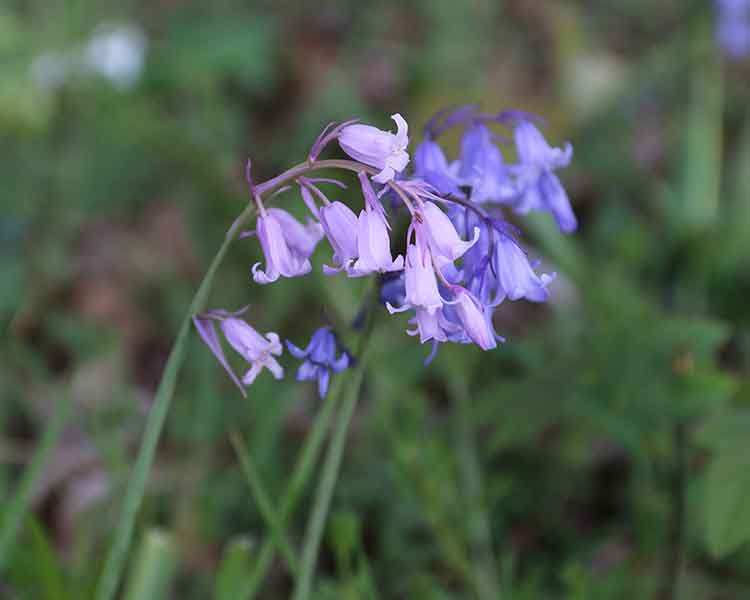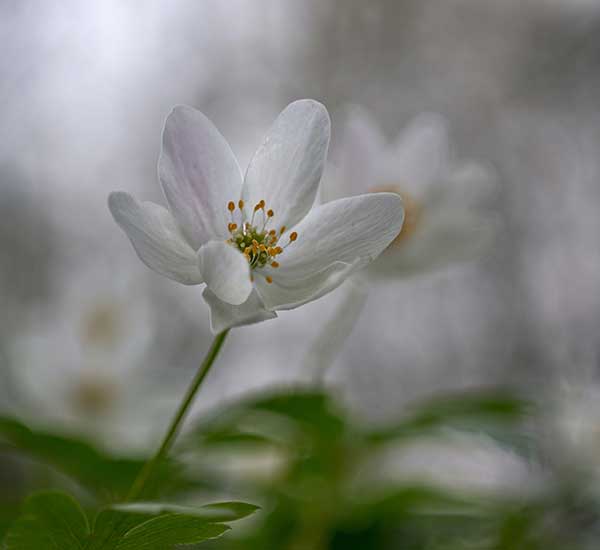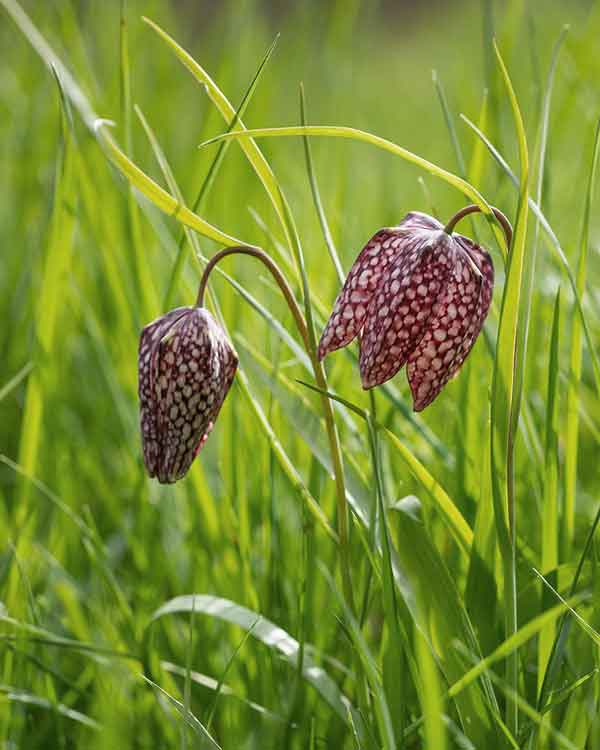Trying to create a wild meadow garden is not a quick project, certainly not as simple as letting your lawn run wild. The benefit to wildlife, especially butterflies is clear from the very first year, but there is still a sad lack of flowers in amongst the grass. I’m not aiming at flowers everywhere, but the nature of wildflowers seems to run to smaller less showy plants.

This is most likely always going to be a Spring/Early Summer garden with a once a year cut in Autumn so it just starts to shine in April. The frustration mainly comes from having wildflowers settle into the garden everywhere but the meadow. Campion loves living under my roses. Violets love the gravel path. Heck, everything loves the damn gravel!
Having said that, a few years in and we’re starting to see some progress, partly thanks to deliberate planting of bulbs and partly due to nature doing its thing.
Last Autumn we deliberately planted three dense splurges of bulbs under cloches as well as spreading out across the wider lawn. As a result, we have three mats of crocus, small tulips, bulb hyacinth and narcissus that were protected (somewhat) from the squirrels that can now start to clump up and colonise. It feels as though planting dense clumps will be more successful in terms of naturalising the grass since I’m loathe to clear the grass with weedkiller for planting and the root mass is so dense. Whilst most of the daffodils in flower beds have gone over, the barenwyn variety planted last year and supposedly closer to the wild version, is only now appearing in the meadow, a slightly darker and drier part of the garden.
Here are some of the wild flowers that can be spotted at the moment …
1. Primrose (Primula Vulgaris)
These are almost impossible to avoid walking along my gravel path, and yet are very shy in our meadow lawn. They can be found, but the dense roots of the grass make it a difficult environment for flowers to break through and the primroses are still struggling. In a real meadow, the animals grazing would have broken up the grass, creating bare spots and breaking through the roots of the sod to make life easier for wildflowers. Still, their pale yellow flowers really stand out against the green so the few we have are lovely. Primroses can appear as early as December all the way through until May, so April is the peak time to see them looking their flashy best.

2. Sweet Violet (Viola Odorata)
A culinary favourite due to its sweet taste, this small edible purple flower is often used as decoration on cakes or in salads. Sadly, it’s wonderful taste have caused it’s decline in the UK after being over-picked by foragers. In addition, this wild flower’s delicate scent has led it to being a common ingredient of perfumes, dating back to the Greek and Roman times. In the wild they are mainly found on banks or in meadows, but a keen eye is needed as they grow very low to the ground.
In my garden, yet again they grow very easily in the gravel path (tricky to get rid of to be honest) but spotting them in the meadow lawn is trickier.

3. Cow Parsley (Anthriscus Sylvestris)
These tall, exuberant wild flowers are everywhere in the UK, and a plant that I don’t really want to see too much of – I’m taking these out of the meadow before they take over. The wide brimmed white clusters of blooms sit atop a long vibrant green stem and are super common at roadsides or garden edges. A distant relative of the carrot, this plant provides food for all kinds of British wildlife. Note: they taste nothing like carrots.

4. Bluebells (Hyacinthoids Non-Scripta)
If you haven’t ever seen a bluebell wood in all it’s glory, now is the time to get out there and discover one. With around 50% of the worlds bluebells being found in the UK, we are privileged to be able to see this natural spectacle every year between mid-April and the end of May. The sweet smelling bell-shaped blooms carpet the ground of ancient woodland, making it easy to see why there are so many folklore tales surrounding these wild flowers. Easy to spot due to the bright blue colour, bluebells are often inundated with hungry bees, hoverflies and butterflies which enjoy feasting on the nectar.
I planted bulbs of these wild flowers into the meadow quite deliberately a year or two ago and am waiting for them to clump up and naturalise. If you plan to plant bluebells, make sure you get the UK version rather than Spanish which will overtake the indigenous version. At the moment they’re green shoots scattered through the grass about to flower.
Find a bluebell wood near you by using this fab guide by the Woodland Trust; https://www.woodlandtrust.org.uk/visiting-woods/things-to-do/woods-through-the-seasons/spring/best-bluebell-woods/ Bluebell carpet, Norfolk
Bluebell carpet, Norfolk Bluebell, also known as cuckoo’s boots
Bluebell, also known as cuckoo’s boots
5. Greater Stitchwort (Stellaria Hollostea)
A delicate and easily overlooked wild flower, this small white bloom provides nectar for not only bees and butterflies, but also moths which rely on this essential food source. They open in April and the flowers turn to seed pods by June, which pop loudly and are a signal of summer – earning it the nickname ‘poppers’. Most commonly found in woodlands and although widespread, this small flower will require a little hunting down.
In the meadow, it’s one of the plants growing underneath the yew hedge.

Greater Stitchwort – also known as the ‘Star-of-Bethlehem’
6. Wild garlic, Ramsons (Allium Ursinum)
This is currently taking over the woodland part of my garden, a surprise since it’s very shady and very dry. This year, I plan to transfer some of the plants to the meadow to see whether they like the environment.
Wild ramsons produce a tall, straight stalk with a cluster of fluffy white flowers on the top. An almost exotic looking plant with wide green leaves, it is more well known as ‘wild garlic’ and is one of the most popular foods for foragers to pick. When I was growing up, they grew alongside blue bells in the local woods so I’m hopeful that they’ll enjoy the meadow as much as the bluebells seem to enjoy it.
The whole plant from flower to root can be eaten, but if you are simply looking to observe this plant, chances are you’ll smell the garlic wafting through the woods before you see it. Much like bluebells, ramsons can overtake an entire woodland floor.

Wild Garlic, also known as Bear Leek
7. Ground Ivy (Glechoma Hederacea)
Growing barely a few centimetres above the ground, and producing only a few tiny lilac blooms that somehow blend into the green of grass, this is a tough wild flower to find. It’s actually a part of the dead nettle family (more on those shortly) but it’s habit of spreading widely has led it to being called ‘ivy’. Interestingly, despite its small stature, this plant kicks out a strong scent, and before hops were discovered it was frequently used in the beer brewing process.

8. Summer Snowflake (Leucojum Aestivum)
Not be confused with the snowdrops which bloom between January and March, these slightly larger, taller white wild flowers have very rounded bell-shaped blooms with small green dots on the tip of each petal. Does it compare in beauty to the more well know snowdrop? Well, that’s personal opinion.. Spot them on banks and in woodlands, often close to water sources.
I’ve planted some bulbs in a clump in the meadow and also in the woodland to try and see which environment works best for them. Hopefully at least one colony will succeed

9. Forget-me-not (Myosotis)
The tiny bright blue flowers of forget-me-not have to be one of the most loved blooms of all. Although they were originally a wild flower, these minuscule blue beauties are now more commonly found sprawling in gardens, giving rise to arguments as to whether they are indeed still a wild flower or not. They are currently thriving in my flower beds and making a brave attempt to break into the meadow.

10. Common Chickweed (Stellaria Media)
Another minuscule flower that will require a little patience to find, but is nonetheless fairly widespread throughout the UK. It’s mostly thought of as a weed, but can actually be eaten in salads and is a valuable source of nectar for tiny insect species. It’s actually pretty useful in the meadow at that point where the grass starts to thin towards the yew hedge – tough as old boots.

Common Chickweed – does actually get fed to chickens.
11. Garlic Mustard (Alliaria Petiolata)
Occasionally mistaken for a stinging nettle, this tall and impressive plant is crowned with white cross shaped flowers and gives off a faint whiff of garlic. As with many wild flowers, it is popular for use in cooking, particularly salads. It often grows in hedgerows and along roadsides, making it easy to discover.
It’s one of the plants I intend to take out – too much green and not enough flower for something of a bully plant.

Garlic Mustard – not a stinging nettle!
12. Common Comfrey (Symphytum Officinale)
This is another flower which is often considered to be a weed, yet has some incredible properties and is one of the best early food sources for bees particularly. Its deep roots drag nutrients to the surface of the soil for other plants to utilise and it makes good nitrogen rich compost.
A friend gave me some roots of this and it’s now taking over the woodland plot. The droopy bell shaped flower heads range in colour from white and cream to pinks and purples, looking strangely almost wilted. It naturally repels slugs and once it’s flowers I can take it right back to the soil and know it will come back next year – a lovely thug.
 Comfrey in pink
Comfrey in pink Comfrey in white
Comfrey in white
13. Bulbous Buttercup (Ranunculus Bulbosus)
Do you like butter – hold one of these flowers under your chin. If the golden yellow shines off your skin, then you do.
It’s found in most gardens, on road sides and along almost all footpaths and in my garden scatters itself through the grass.

14. White or Purple Dead Nettle (Lamium Album?)
THEY DO NOT STING! In fact, the dead nettle can make a tasty addition to salads. It’s super common and easy to find – often found close to real stinging nettles so take care if you are foraging. It’s easy to overlook these blooms as being ‘boring’ as they are everywhere, but close up the petals are almost orchid-like. It’s currently growing in amongst the chickweed and feeding early butterflies and bees.
 White Dead Nettle
White Dead Nettle  Purple Dead Nettle
Purple Dead Nettle
15. Cowslip (Primula Veris)
A fabulous little wild flower which has many uses, from helping cure coughs, to providing citrus flavour in food and flavouring wine. Tall and bright yellow, favouring meadows and open woodland, I’m still trying to find this in my meadow after last year planting

Cowslip, also known as Fairy Cups.
16. Lesser Celandine (Ficaria Verna)
This bright yellow member of the buttercup family starts blooming as early as December, and finishes in Apri. It’s a cheerful flower, supposedly found in damp woodlands or sprawling on shady bank sides yet absolutely happy in the driest spots of my meadow maybe because of the lack of competition from grass. With a high vitamin C content, this plant has been used for medicinal purposes in the past, and for insects it is a precious food source.

Lesser Celandine – also known as Pilewort (note in the picture a bulbous buttercup on the bottom left showing the difference in petal shape)
17. Dandelion (Taraxacum Officinale)
Prized for its flavour and long list of health benefits, it is regularly used in making salads, tea and even wine. It’s classed as a weed, and gardeners countrywide hate them with a passion. However, for the pollinators of springtime, they are essential food banks and of course children love blowing the fluffy seed heads known as ‘clocks’ to tell the time.
Bizarrely I can hardly find any dandelions in my meadow lawn.

Dandelion – has hundreds of uses
18. Common Daisy (Bellis Perennis)
Unmistakable and a children’s favourite – who hasn’t made a daisy chain?! Although this tiny, hardy flower is seen throughout the year – they’re just beginning to pop up through the grass

The Common Daisy – a childhood fave
19. Wood Anemone (Anemone Nemorosa)
A sure sign that the woodland you are walking through is ancient, this flower has signalled the arrival of spring for centuries. This delicate bloom is names after Anemos, the Greek god of wind, hence their other name; Wind Flowers. The leaves smell slightly musky.
Having planted some of these around both the meadow and the wood plot, the only ones I can find are popping up in nearby flower beds (thanks to the squirrel relocation service)

Wood Anemone – also known as ‘Wind Flowers’
20. Snake’s Head Fritillary (Fritillaria Meleagris)
Immediately identifiable and one of the most unusual wild flower species in this list, this beautiful bloom is now classed as vulnerable in the UK. So called because of the snake-like pattern on it’s petals, it has been the subject of a huge conservation effort across the country.
I deliberately planted loads of these in the meadow, including the white version to make them easier to spot. As a result they’re looking beautiful in amongst the grass and encourage people to look closer and then spot some of the smaller flowers.
Frustrating as always, the gravel path is currently chock-a-block with these.

Snake’s Head Fritillary – now classed as a vulnerable species in the UK
As always with any activity in the great outdoors, please take care not to trample or upset the species growing nearby. Wild flowers are particularly delicate and all too often in the meadow, the prettiest flowers are the ones my husband has just squashed flat with his shoes.





